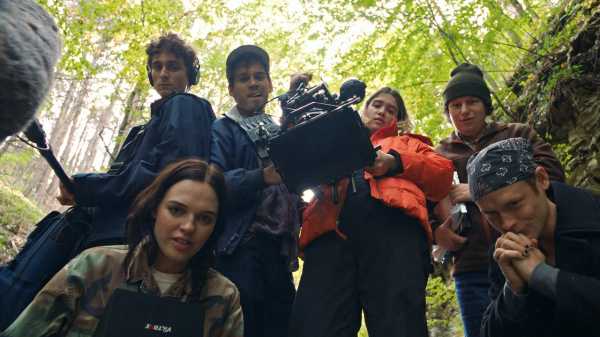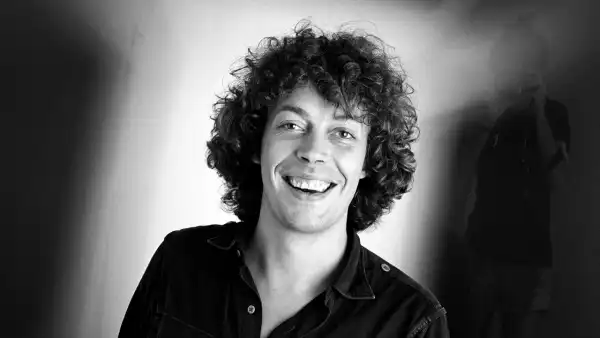
Save this storySave this storySave this storySave this story
Some filmmakers have remade their own films, others have made adapted works they created in other media, many have made films about filmmaking, and many more have dramatized their private lives. Leave it to an American independent filmmaker, working on a low budget, to do all four at once, as Zia Anger does with her new movie, “My First Film” (which will be streaming on MUBI starting September 6th). What’s more, she ups the ante on all four, turning this mashup of modes and themes into a kaleidoscopic trip of narrative intricacy and personal exploration. This immensely complex film nonetheless tells a straightforward, real-life story: how, more than a decade ago, Anger tried to make a low-budget independent feature, titled “Gray,” and get it shown, and how she ultimately failed in her aims. “My First Film,” which looks back at a young filmmaker’s crises and conflicts, is both a masterwork of an artistic coming of age and a virtuosic reconception of the art of cinema itself.
There’s another work embedded in “My First Film.” (Bear with me; this film is a far stranger one to describe than it is to watch.) In 2019, Anger created a performance piece, also called “My First Film,” on the same subject. Anger sat near the audience in a movie theatre, with a laptop whose screen was projected onto the theatre’s big screen. She manipulated a wide array of images and windows (including scenes from the unreleased film and many related photos and documents from her personal archive) while typing out, onto the screen, a commentary in which she told the story and reflected on it. After seeing the show—with astonished admiration—I hoped that Anger would film it, to make it rewatchable and permanent. But, in making the movie of “My First Film,” she went much further, not merely recording a live performance but transforming it—in a way that reclaims the project’s essential state as a movie. The new film is a redemptive restoration, and expansion, of what the original one was meant to be.
In “My First Film”—the movie (and that’s what that title will refer to here)—Anger employs the most classical of cinematic forms, the realist drama, to tell the story of the shoot. In this dramatization, Anger’s original film, which she called, in the performance, “Gray,” is titled “Always All Ways, Anne Marie”; Anger becomes a character named Vita, played by Odessa Young; and other actors play the cast and crew of the film within a film and Vita’s friends and family. Vita returns to her home town in upstate New York to make “Always All Ways.” She has a small cast and crew, including the movie’s lead actress, Dina (Devon Ross), and its leading man, Cash (Abram Kurtz). Dina plays a woman who, when she gets pregnant, leaves her home town and her ailing father in order to reconnect with her mother, who had abandoned her. “Always All Ways” is also a love story, involving a boyfriend and a secret lover. Meanwhile, as Vita is shooting this story, her boyfriend, Dustin (Philip Ettinger), is there on location, adding a distracting fuzz of emotional static to her artistic efforts. Then, during the shoot, Vita discovers that she’s pregnant, and decides to have an abortion.
Vita has little experience working with a cast and a crew. She is, at times, indecisive, at others, overly casual, and also needlessly arrogant, insulting participants for slight mishaps and artistic difficulties. Her cinematographer, Alexis (played by Jane Wickline), is forced to step in with much-needed reality checks several times. But what marks the shoot with an indelible stain of guilt is her callous indifference toward the well-being of the cast and crew, in her reckless quest to make the film as real as possible. There is one incident that had grievous consequences, and that, all the more grievously, she seeks to cover up.
Though this underlying story is dramatized in a naturalistic way, it is seen only in chunks and snatches, and surrounded by a wildly disparate range of other elements. Just as Anger, in the performance piece, used footage from her unreleased film as raw material for her autobiographical narrative of its creation, so, in “My First Film,” she maneuvers and manipulates the material of Vita’s film into a boldly original form of cinematic collage. There are extended film-within-the-film sequences from “Always All Ways,” plus stills, home videos, other footage that Vita shot, material from other unrealized projects, and views of her computer screen, too. And, to this extravagant mix, Anger adds the primal element of storytelling. The typed-out narrative she delivered in her live performance has its counterpart in the film: a spoken monologue that Vita directly addresses to the audience, mainly in voice-over but also, at times, on camera, where she is shown at home in front of her computer.
Vita’s mix of recollection and reflection expands on what the dramatized scenes show, and also, crucially, sometimes creates ambiguities about exactly what happened. Vita certainly blames herself for the disasters of the shoot, whose main motif she sums up as “near-death,” recalling several dangers to which she heedlessly subjected her colleagues. Nonetheless, what is seen in snippets from Vita’s film and of the process of its creation make it apparent that it—like, by implication, Anger’s own unreleased feature—is a work of audacious artistry. The underlying passion that drives it is twofold, and both have to do with parents and childbirth. First, Vita’s own experiences of pregnancy and abortion, which, as she makes clear in her voice-over, underpin the entire film project. Second, her family background. She has two mothers and was conceived nonsexually with her biological father (played by Ruby Max Fury, a remarkable onscreen presence), a story so distinctive that he was himself encouraged to make it into a movie. The camera with which he’d planned to do so now comes into Vita’s hands; one of her mothers, a mime, delivers a performance on camera about menstruation that also sparks Vita’s cinematic imagination.
The panoply of forms unleashed by Anger’s high cinematic modernism highlight the underlying tension of dramatic fiction—the conflict between observation and declaration, between the masks of drama in which filmmakers portray their experience and the undisguised voice, the unconcealed presence of filmmakers revealing their experiences and emotions to viewers. Anger, moving through multiple levels of fiction and documentary with a vertiginous rapidity, turns a story about process into a new cinematic process in itself.
American independent filmmaking since the start of this century has been an age of artistic radicalism, in the etymologically literal sense that filmmakers such as Josephine Decker and Terence Nance have been going back to the roots of filmmaking and reconsidering its essential elements—image and sound, performance and dialogue, montage and narrative. In “My First Film,” Anger explicitly situates her own story, the making of her own unreleased movie, in the recent history of independent filmmaking. She has Vita explain: “It was the middle of what could be described as a revolutionary decade in moving images. The aftermath of a world financial collapse coupled with the rise of the first affordable and professional digital moving-image cameras created an era of micro-budget filmmaking.” I think there’s a little more to it than that; after all, some of the revolutionary independent movies of this era, such as “Frownland” and “Funny Ha Ha,” were made before the crisis and were shot on film, not video. Still, the basic point is clear and true: the time was ripe for scrutiny and revision of fundamental cinematic principles and unquestioned habits, and filmmakers emerged who were equal to the challenge.
The times also called for challenges to established systems of production. “My First Film” is more than a story of the troubled shoot of “Always All Ways,” and of the troubled life that Vita was leading even before trying to make it; it’s also an account of Vita’s struggles with the business. Despite the wrangling on and off set, Vita’s movie got made—but was then rejected from every festival to which she submitted it. The same thing happened to Anger’s original feature, “Gray,” the excerpts that she showed in her 2019 performance are, however, very good. (Both “My First Film” and “Gray” were shot by Ashley Connor, whose free and rapturous images have a startling immediacy.) In “My First Film,” Vita tells the story of another rejection: a production company with an ostensibly feminist focus turned down her proposal to make a film based on her mother’s mime performance about menstruation. She says that she sent back a counterproposal: to make a film about her proposal, their rejection of it, and their effort to dictate a subject and a format to her.
Reflexivity and the revelation of the mechanisms of production, of power, and of cinematic form as they affect a female filmmaker have thus long been on Anger’s mind. In her 2019 performance, she expressed frustration with herself for failing, in the film, to address directly the underlying personal story that motivated it: her pregnancy and her abortion. In “My First Film,” Vita expresses a similar frustration with herself for not directly addressing details of her own life, and for reasons that aren’t her failures alone: “I think I made the main character live this parallel life to mine because I didn’t know how to talk about these things, or I didn’t trust the rules of cinema to do them justice, or I was afraid to.” It’s then—when Vita’s film spins out of control and she’s alone, with her shoot behind her and the project feeling like a failure even before its rejection by independent-film gatekeepers—that “My First Film” hits a dramatic impasse and awaits a new jolt of energy to break it through that dramatic wall.
Anger finds one, in the personal, off-the-set friendship between Vita and her lead actress, Dina. And Anger redoubles the point, when she herself shows up in the film and depicts her friendship with Young, the actress playing Vita. Their personal connection blossoms out into a quietly exultant scene with the rest of the cast and the crew, a symbolic utopia of shared purpose. This collective energy helps the fictional filmmaker and the real-life one break out of the so-called rules of cinema and overcome fear. It’s not just the end of the film; it’s the beginning, of new possibilities in filmmaking, which are displayed in an envoi that’s too great to spoil. The movie ends with a dramatic stroke of a singular, vast inspiration, a blend of live action and mime, of realism and fable, centered on a crucial event in Anger’s and Vita’s experiences, the sort of moment that defies representation and that Anger nonetheless puts onscreen with an originality and an audacity that are as personal as the events that they bring to life, as revolutionary as the times demand. ♦
Sourse: newyorker.com






